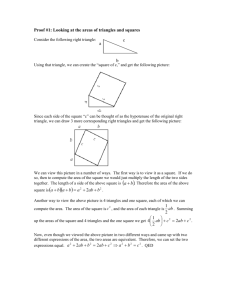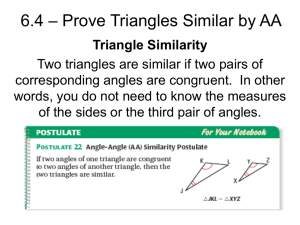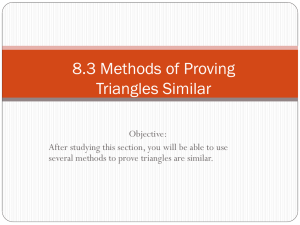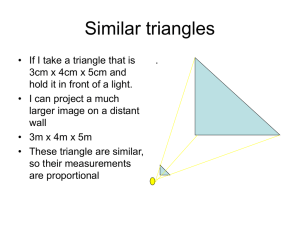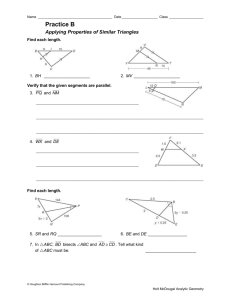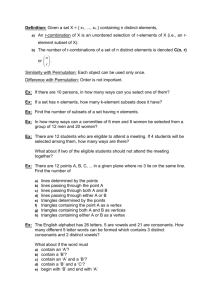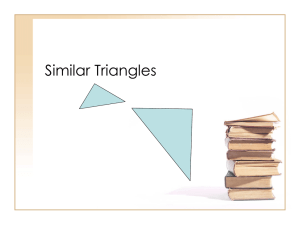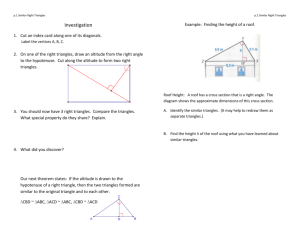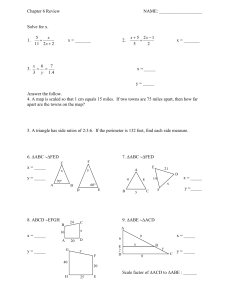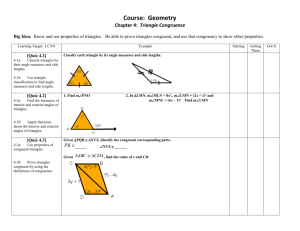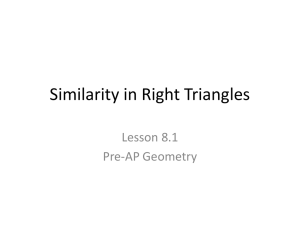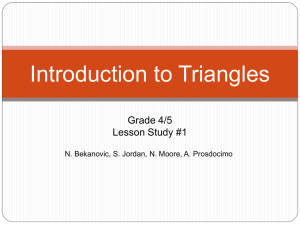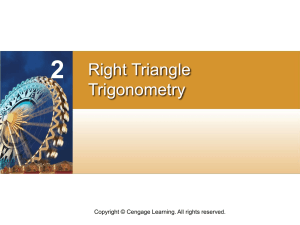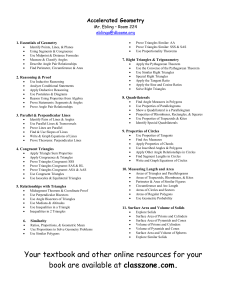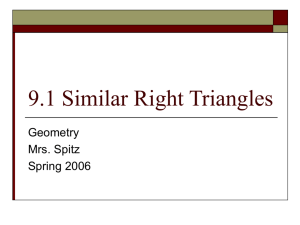Pythagorean Theorem proof with similar right triangles
advertisement
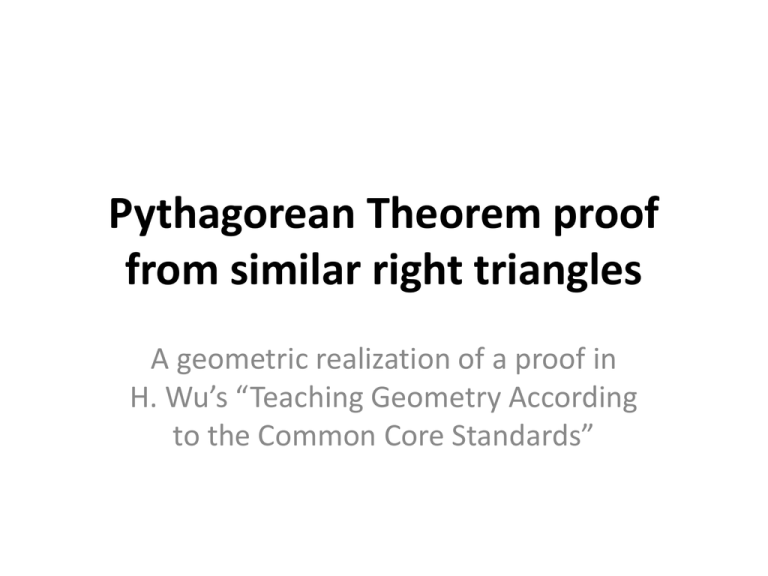
Pythagorean Theorem proof from similar right triangles A geometric realization of a proof in H. Wu’s “Teaching Geometry According to the Common Core Standards” Given a right triangle ABC with legs a and b and hypotenuse c. Prove a2 + b2 = c2 A c b C a B In other words, prove that the sum of the areas of the squares on the legs a and b A c2 c is equal to the area of the square on the hypotenuse c. b2 b C a a2 B But how can we possibly prove that is equal to the sum of the areas of these the area of this? c2 a2 b2 ? We don’t have to prove that the figures are equal— they aren’t! All we have to do is prove that the area of the two little squares equals the area of the big square. Maybe if we could partition the big square into 2 rectangles, one equal in area to a2, and the other to b2… c2 a2 b2 Hang onto that dream as we proceed… We’ll partition ABC into 3 similar right triangles and use the equal ratios of their corresponding parts in our proof. Draw a perpendicular to the hypotenuse AB through the vertex of the right angle at C. That perpendicular intersects AB at a point we’ll call D. A c D b C a B Now we have 3 similar right triangles: ABC, the big one we started with, containing A and B, A ACD, the little one that contains A, D b C and BCD, the other little one that contains B. c a B We know all 3 triangles are similar by AA: two pairs of equal corresponding angles make similar triangles. c A Each triangle has a right angle, and all right angles are equal. D b C And each triangle contains either A or B or both. a B Reflection, translation, and rotation enable a nice arrangement of our 3 similar triangles. A D A a b b D C C C a B D B A reflection across AC A reflection across DB A translation A translation Then a rotation Then a rotation Similar triangles means that the ratios of their corresponding parts will be equal. c A A C D b D C ABC a b C a B CBD 𝒉𝒚𝒑𝒐𝒕𝒆𝒏𝒖𝒔𝒆 𝒉𝒚𝒑𝒐𝒕𝒆𝒏𝒖𝒔𝒆 = 𝒍𝒐𝒏𝒈 𝒍𝒆𝒈 𝒍𝒐𝒏𝒈 𝒍𝒆𝒈 D |𝐵𝐴| |𝐵𝐶| = |𝐵𝐶| |𝐵𝐷| B By the cross-multiplication algorithm… c A A D C D a b b C a C B D |𝐴𝐵| |𝐵𝐶| = |𝐵𝐶| |𝐵𝐷| |𝐵𝐶|2 = 𝐴𝐵 ∙ |𝐵𝐷| 𝑠𝑢𝑏𝑠𝑡𝑖𝑡𝑢𝑡𝑖𝑛𝑔 𝑎2 = 𝑐 ∙ |𝐵𝐷| B Now we have 𝒂𝟐 = 𝒄 ∙ |𝑩𝑫| 𝑐 ∙ 𝐵𝐷 A 𝑎2 is the area of the square on leg 𝑎. c D C a a2 𝑐 ∙ 𝐵𝐷 is the area of the rectangle with sides 𝑐 and 𝐵𝐷. B Looking at the left triangles, similarity gives us c A A D C D a b b C ACD C a B ABC 𝒔𝒉𝒐𝒓𝒕 𝒍𝒆𝒈 𝒔𝒉𝒐𝒓𝒕 𝒍𝒆𝒈 = 𝒉𝒚𝒑𝒐𝒕𝒆𝒏𝒖𝒔𝒆 𝒉𝒚𝒑𝒐𝒕𝒆𝒏𝒖𝒔𝒆 D |𝐴𝐷| |𝐴𝐶| = |𝐴𝐶| |𝐴𝐵| B By the cross-multiplication algorithm, we have c A A D C D a b b C a C B D |𝐴𝐷| |𝐴𝐶| = |𝐴𝐶| |𝐴𝐵| |𝐴𝐶|2 = 𝐴𝐵 ∙ |𝐴𝐷| 𝑠𝑢𝑏𝑠𝑡𝑖𝑡𝑢𝑡𝑖𝑛𝑔 𝑏 2 = 𝑐 ∙ |𝐴𝐷| B And now we have Could this be the partition we had been dreaming of? c 𝒃𝟐 = 𝒄 ∙ 𝑨𝑫 A D b2 b C a B 𝑏 2 is the area of the square on leg 𝑏. 𝑐 ∙ 𝐴𝐷 is the area of the rectangle with sides 𝑐 and 𝐴𝐷. Putting it together… c 𝑎2 = 𝑐 ∙ |𝐵𝐷| A 𝑏 2 = 𝑐 ∙ |𝐴𝐷| D b2 Adding, we get 𝑎2 + 𝑏2 c c b C = 𝑐 ∙ 𝐵𝐷 + 𝑐 ∙ |𝐴𝐷| a a2 B Since 𝑎2 + 𝑏 2 = 𝒄 ∙ 𝐵𝐷 + 𝒄 ∙ |𝐴𝐷| We distribute out 𝒄 and get 𝑎2 + 𝑏 2 = 𝒄 ∙ ( 𝐵𝐷 + 𝐴𝐷 ) A We notice that 𝑐 = 𝐵𝐷 + 𝐴𝐷 c2 b2 so we substitute for 𝐵𝐷 + 𝐴𝐷 , giving us 𝑎2 + 𝑏 2 = 𝑐 ∙ (𝑐) and finally 𝑎2 + 𝑏2 = 𝑐 2 cc D 𝑐 b C a a2 B

